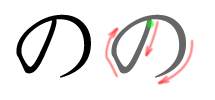Top Qs
Timeline
Chat
Perspective
No (kana)
Character of the Japanese writing system From Wikipedia, the free encyclopedia
Remove ads
の, in hiragana, and ノ, in katakana, are Japanese kana, both representing one mora. In the gojūon system of ordering of Japanese morae, it occupies the 25th position, between ね (ne) and は (ha). It occupies the 26th position in the iroha ordering. Both represent the sound [no]. The katakana form is written similar to the Kangxi radical 丿, radical 4.
This article has multiple issues. Please help improve it or discuss these issues on the talk page. (Learn how and when to remove these messages)
|
Remove ads
Stroke order
 |
 |
 |
 |
To write の, begin slightly above the center, stroke downward diagonally, then round upward and continue curve around, leaving a small gap at the bottom. To write ノ, simply do a swooping curve from top-right to bottom left.
Other communicative representations
| Japanese radiotelephony alphabet | Wabun code |
| 野原のノ Nohara no "No" |
ⓘ |
 |
 | ||
| Japanese Navy Signal Flag | Japanese semaphore | Japanese manual syllabary (fingerspelling) | Braille dots-234 Japanese Braille |
- Full Braille representation
Remove ads
History
This section possibly contains original research. (March 2025) |
The leftmost, predominantly vertical segment of the man'yōgana was used to create the katakana ノ.
When the kanji 乃 is written in the highly cursive, flowing grass script style, it begins to resemble the hiragana の.
Hentaigana and gyaru-moji variant kana forms of no can also be found.
Usage
Summarize
Perspective
の is a dental nasal consonant, articulated on the upper teeth, combined with a close-mid back rounded vowel to form one mora.
In the Japanese language, as well as forming words, の may be a particle showing possession. For example, the phrase "わたしのでんわ” watashi no denwa means "my telephone."
In Chinese

の has also proliferated on signs and labels in the Chinese-speaking world. It is used in place of the Modern Chinese possessive marker 的 de or Classical Chinese possessive marker 之 zhī, and の is pronounced in the same way as the Chinese character it replaces. This is usually done to "stand out" or to give an "exotic/Japanese feel", e.g. in commercial brand names, such as the fruit juice brand 鲜の每日C, where the の can be read as both 之 zhī, the possessive marker, and as 汁 zhī, meaning "juice".[8] In Hong Kong, the Companies Registry has extended official recognition to this practice, and permits の to be used in Chinese names of registered businesses; it is thus the only non-Chinese symbol to be granted this treatment (aside from punctuation marks with no pronunciation value).[9]
Remove ads
References
External links
Wikiwand - on
Seamless Wikipedia browsing. On steroids.
Remove ads


